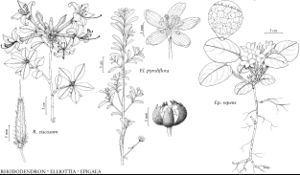Difference between revisions of "Rhododendron viscosum"
Fl. N. Middle United States, 424. 1824 ,.
FNA>Volume Importer |
imported>Volume Importer |
||
| (5 intermediate revisions by 2 users not shown) | |||
| Line 7: | Line 7: | ||
}} | }} | ||
|common_names=Swamp or clammy azalea | |common_names=Swamp or clammy azalea | ||
| − | |basionyms={{Treatment/ID/ | + | |special_status={{Treatment/ID/Special_status |
| + | |code=F | ||
| + | |label=Illustrated | ||
| + | }}{{Treatment/ID/Special_status | ||
| + | |code=E | ||
| + | |label=Endemic | ||
| + | }} | ||
| + | |basionyms={{Treatment/ID/Basionym | ||
|name=Azalea viscosa | |name=Azalea viscosa | ||
|authority=Linnaeus | |authority=Linnaeus | ||
| + | |rank=species | ||
| + | |publication_title=Sp. Pl. | ||
| + | |publication_place=1: 151. 1753 | ||
}} | }} | ||
|synonyms={{Treatment/ID/Synonym | |synonyms={{Treatment/ID/Synonym | ||
|name=Azalea oblongifolia | |name=Azalea oblongifolia | ||
|authority=Small | |authority=Small | ||
| + | |rank=species | ||
}} {{Treatment/ID/Synonym | }} {{Treatment/ID/Synonym | ||
|name=Azalea serrulata | |name=Azalea serrulata | ||
|authority=Small | |authority=Small | ||
| + | |rank=species | ||
}} {{Treatment/ID/Synonym | }} {{Treatment/ID/Synonym | ||
|name=Rhododendron coryi | |name=Rhododendron coryi | ||
|authority=Shinners | |authority=Shinners | ||
| + | |rank=species | ||
}} {{Treatment/ID/Synonym | }} {{Treatment/ID/Synonym | ||
|name=Rhododendron oblongifolium | |name=Rhododendron oblongifolium | ||
|authority=(Small) Millais | |authority=(Small) Millais | ||
| + | |rank=species | ||
}} {{Treatment/ID/Synonym | }} {{Treatment/ID/Synonym | ||
|name=Rhododendron serrulatum | |name=Rhododendron serrulatum | ||
|authority=(Small) Millais | |authority=(Small) Millais | ||
| + | |rank=species | ||
}} {{Treatment/ID/Synonym | }} {{Treatment/ID/Synonym | ||
|name=Rhododendron viscosum var. serrulatum | |name=Rhododendron viscosum var. serrulatum | ||
|authority=(Small) H. E. Ahles | |authority=(Small) H. E. Ahles | ||
| + | |rank=variety | ||
}} | }} | ||
|hierarchy=Ericaceae;Ericaceae subfam. Ericoideae;Rhododendron;Rhododendron viscosum | |hierarchy=Ericaceae;Ericaceae subfam. Ericoideae;Rhododendron;Rhododendron viscosum | ||
| Line 53: | Line 69: | ||
-->{{#Taxon: | -->{{#Taxon: | ||
name=Rhododendron viscosum | name=Rhododendron viscosum | ||
| − | |||
|authority=(Linnaeus) Torrey | |authority=(Linnaeus) Torrey | ||
|rank=species | |rank=species | ||
| Line 67: | Line 82: | ||
|publication title=Fl. N. Middle United States, | |publication title=Fl. N. Middle United States, | ||
|publication year= | |publication year= | ||
| − | |special status= | + | |special status=Illustrated;Endemic |
| − | |source xml=https:// | + | |source xml=https://bitbucket.org/aafc-mbb/fna-data-curation/src/2e0870ddd59836b60bcf96646a41e87ea5a5943a/coarse_grained_fna_xml/V8/V8_922.xml |
|subfamily=Ericaceae subfam. Ericoideae | |subfamily=Ericaceae subfam. Ericoideae | ||
|genus=Rhododendron | |genus=Rhododendron | ||
Latest revision as of 22:47, 5 November 2020
Shrubs or trees, to 7 m, rhizomatous or not. Stems: bark smooth to vertically furrowed, shredding; twigs sparsely to conspicuously multicellular eglandular-hairy (hairs unbranched), otherwise glabrous or densely unicellular-hairy. Leaves deciduous; petiole usually multicellular eglandular-hairy and unicellular-hairy; blade ovate to obovate, 2–7(–9) × 1–3(–3.8) cm, ± thin, membranous to chartaceous, margins entire or, sometimes, minutely serrulate, plane, ciliate, eglandular-hairy, apex acute to obtuse, often mucronate, abaxial surface glabrous or densely unicellular-hairy, adaxial surface (lustrous or dull), glabrous or sparsely scattered eglandular-hairy, sometimes also sparsely unicellular-hairy. Floral bud scales glabrous or densely unicellular-hairy abaxially (sometimes with sharply marked, dark brown band along distal margins), margins unicellular-ciliate or, sometimes, glandular-serrulate. Inflorescences 3–14-flowered; bracts similar to bud scales. Pedicels 5–27 mm, stipitate-glandular- or, sometimes, eglandular-hairy, otherwise sparsely to densely unicellular-hairy. Flowers opening after leaves, erect to horizontal, slightly to strongly fragrant (most noticeable at night); calyx lobes 0.5–5 mm, surfaces and margins scattered stipitate-glandular-hairy or, sometimes, eglandular-hairy, often also unicellular-hairy; corolla white, sometimes pink-tinged or pink (not strongly contrasting with white or greenish to pinkish style or filaments), without blotch on upper lobe, funnelform, 20–58 mm, usually scattered, often conspicuously stipitate-glandular-hairy (hairs continuing in lines up lobes), otherwise sparsely to moderately unicellular-hairy on outer surface, petals connate, lobes 7–21 mm, tube usually ± gradually expanded into lobes, 13–37 mm (equaling or much longer than lobes); stamens 5, much exserted, ± unequal, 21–65 mm. Capsules borne on erect pedicels, 7–20 × 3–7 mm, usually densely stipitate-glandular- and/or eglandular-hairy, otherwise densely unicellular-hairy to ± glabrous. Seeds without distinct tails, flattened portion of testa well developed at each end; testa expanded, dorsiventrally flattened, ± loose. 2n = 26.
Phenology: Flowering spring–summer.
Habitat: Acid swamps, bogs, seepage slopes, pocosins, streamheads and baygalls, wet pine flatwoods, moist pine or pine/oak forests, hummocks, shrub balds
Elevation: 0-1500 m
Distribution

Ala., Ark., Conn., Del., Fla., Ga., La., Maine, Md., Mass., Miss., N.H., N.J., N.Y., N.C., Okla., Pa., R.I., S.C., Tenn., Tex., Vt., Va.
Discussion
Rhododendron viscosum is the most widespread and variable species of sect. Pentanthera and has been divided into as many as four species: R. coryi, R. oblongifolium, R. serrulatum, and R. viscosum in the narrow sense. In addition, minor varieties and forms have been described. Because correlated or geographically coherent sets of character states cannot be discerned within this species, infraspecific taxa are not recognized here (K. A. Kron 1993). Rhododendron viscosum is most closely related to R. arborescens, and possibly also R. atlanticum. Hybrids with R. cumberlandense and R. arborescens are known. Plants with white corollas and a yellow blotch may be the result of hybridization.
Selected References
None.
